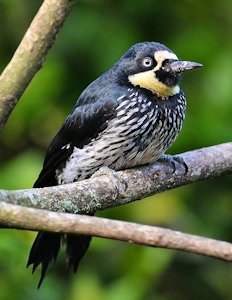
|
Bird Communal Breeding - Page 2 One major task they share is digging the thousands of holes in the storage tree. It takes several generations to dig enough holes for the group to store acorns for the winter. The storage tree is thus a family heirloom. passed from generation to generations. As one tree grows old and begins to totter, the group begins working on another one, thereby ensuring the survival of future generations. For most species, fledging is usually the last interaction between parent and offspring. But with Acorn Woodpeckers, son and daughter stay for at least one year and sometimes even remain on their parents' territory for life. Usually the daughters leave after a year or two, and the sons stay a little longer. Throughout their stay the offspring assist in communal duties -- feeding young, storing acorns, chasing squirrels from the storage tree. They do not breed during this time. If a daughter Acorn Woodpecker remains with its family group, it does not become a breeding member of the group until its father dies. Likewise, unless it has moved to another group, a son does not mate until its mother dies. This cooperative living is not motivated by sheer altruism. The birds need a storage tree to survive the winter. The only way they can obtain access to one is by being in a group, and the only group that will accept then without a fight is their own family. After a year or two they can fight their way into another group. |
| Female Acorn Woodpecker | |
|
How common is cooperative breeding in the United States? There is no other species quite like the Acorn Woodpecker. A few, such as the Florida Scrub Jay, the Gray-breasted Jay, and the Red-cockaded Woodpecker, share similar patterns: Family groups remain together for up to several years to share parenting. Quite a few species show some aspects of cooperation in that young from a previous clutch will help at the nest. |
|